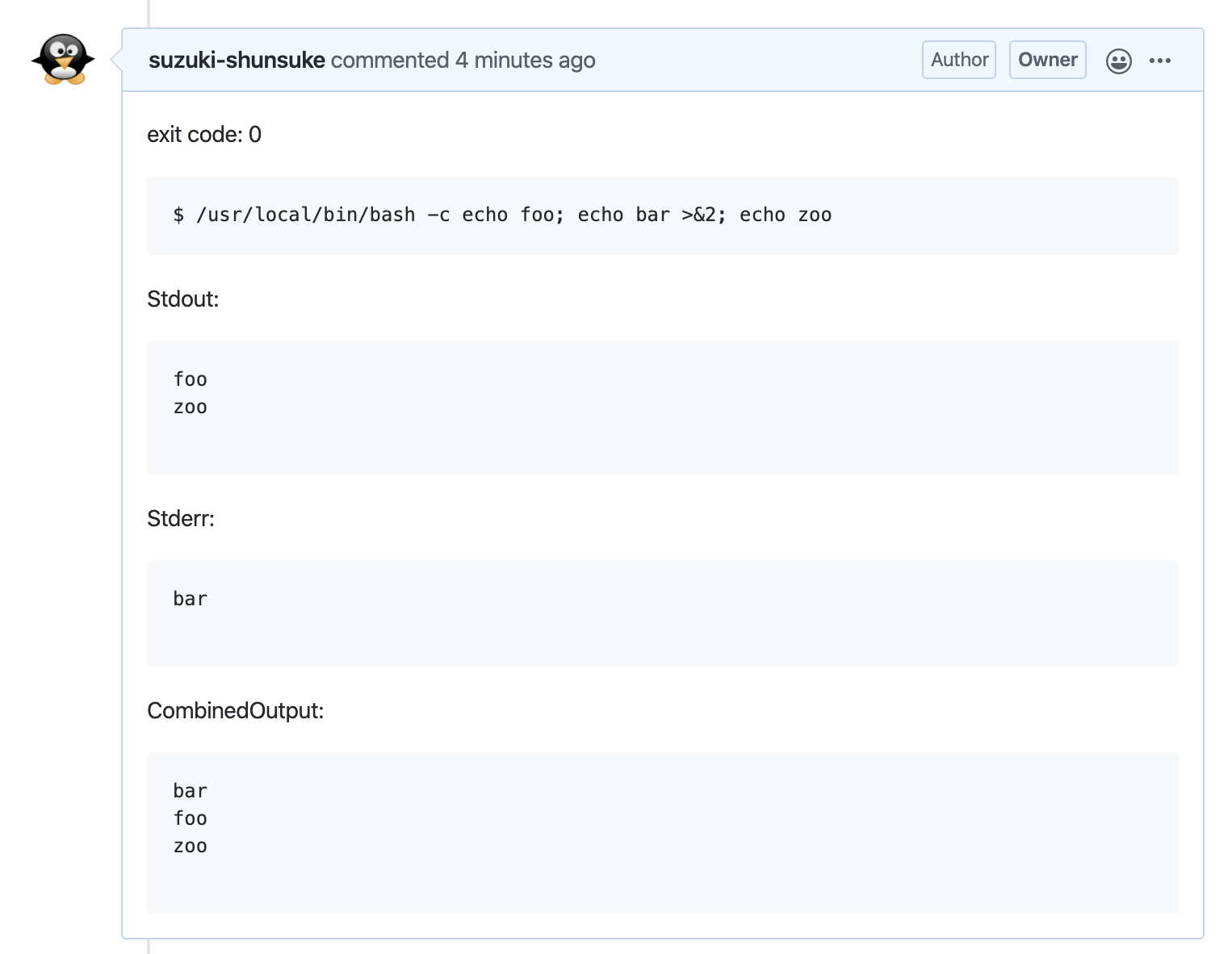Getting Started
Please prepare a GitHub access token. https://github.com/settings/tokens
github-comment provides the following subcommands.
- init: generate a configuration file template
- post: create a comment
- exec: execute a shell command and create a comment according to the command result
- hide: hide pull request or issue comments
post
Let's create a simple comment. Please change the parameter properly.
$ github-comment post -token <your GitHub personal access token> -org suzuki-shunsuke -repo github-comment -pr 1 -template test
https://github.com/suzuki-shunsuke/github-comment/pull/1#issuecomment-601501451

You can pass the API token from the environment variable GITHUB_TOKEN or GITHUB_ACCESS_TOKEN too.
Then you sent a comment test to the pull request https://github.com/suzuki-shunsuke/github-comment/pull/1 .
Instead of pull request, you can send a comment to a commit
$ github-comment post -org suzuki-shunsuke -repo github-comment -sha1 36b1ade9740768f3645c240d487b53bee9e42702 -template test

The template is rendered with Go's text/template.
You can write the template in the configuration file.
github-comment.yaml
post:
default:
template: |
{{.Org}}/{{.Repo}} test
hello:
template: |
hello world
If the argument -template is given, the configuration file is ignored.
You can define multiple templates in the configuration file and specify the template by the argument -template-key (-k).
$ github-comment post -k hello
If -template and -template-key aren't set, the template default is used.
exec
Let's add the following configuration in the configuration file.
exec:
hello:
- when: true
template: |
exit code: {{.ExitCode}}
```
$ {{.Command}}
```
Stdout:
```
{{.Stdout}}
```
Stderr:
```
{{.Stderr}}
```
CombinedOutput:
```
{{.CombinedOutput}}
```
Then run a command and send the result as a comment.
$ github-comment exec -org suzuki-shunsuke -repo github-comment -pr 1 -k hello -- bash -c "echo foo; echo bar >&2; echo zoo"
bar
foo
zoo
https://github.com/suzuki-shunsuke/github-comment/pull/1#issuecomment-601503124

Let's send the comment only if the command failed. Update the above configuration.
exec:
hello:
- when: ExitCode != 0
template: |
...
Run the above command again, then the command wouldn't be created.
If the command failed, then the comment is created.
$ github-comment exec -org suzuki-shunsuke -repo github-comment -pr 1 -k hello -- curl -f https://github.com/suzuki-shunsuke/not_found
% Total % Received % Xferd Average Speed Time Time Time Current
Dload Upload Total Spent Left Speed
0 0 0 0 0 0 0 0 --:--:-- --:--:-- --:--:-- 0
curl: (22) The requested URL returned error: 404 Not Found
exit status 22
https://github.com/suzuki-shunsuke/github-comment/pull/1#issuecomment-601505610
You can change the template by the command result.
exec:
hello:
- when: ExitCode != 0
template: |
command failed
- when: ExitCode == 0
template: |
command is succeeded
By dont_comment, you can define the condition which the message isn't created.
exec:
hello:
- when: ExitCode != 0
dont_comment: true
- when: true
template: |
Hello, world